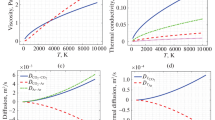Abstract
The modified liquid perturbation variational theory and the improved vdW-1f model were applied to calculating the equation of the state of liquid CO-N2 mixture with the ratio of 1:1, 4:1 and 1:4, respectively, in the shock pressure range of 9–49 GPa. It was shown that the calculated result for CO-N2 mixture with the ratio of 1:1 is well consistent with the earlier experimental data. The thermodynamics equilibrium, chemical equilibrium and phase equilibrium were all considered in detail. It was found that Hugoniot of liquid CO-N2 mixture is moderately softened in the pressure range of 20–30 GPa and 30–49 GPa for different initial proportions, and that the Hugoniot is more softened in the latter pressure range, which means that the structural phase transition occurs near 20 GPa and 30 GPa. Since the shock productions may absorb a plenty of systematic energy, the shock temperature and pressure decline compared with the case of no chemical reaction. Pressures and temperatures increase gradually with the increase in the mole fraction of nitrogen composition. The results for the 1:1 CO-N2 mixture lie in the middle of two others. Therefore, it was shown that the modified Lorentz-Berthelor rule used in the scheme is effective to study shock-compression properties of liquid CO-N2 mixture under high temperatures and high pressures.
Similar content being viewed by others
References
Schott G L, Show M S, Johnson J D. Shocked states from initially liquid oxygen-nitrogen systems. J Chem Phys, 1985, 82(9): 4264–4275
Kujiper D E A, Smit B, Schouten J A, et al. Fluid-fluid phase separation in a repulsive-exp-6 mixture: A comparison with the full-exp-6 mixture by means of computer simulations. J Europhys Lett, 1990, 13(8): 679–683
Moore D S, Schmidt S C, Shaw M S J. Coherent anti-stokes Reman spectroscopy of shock-compressed liquid nitrogen/argon mixtures. J Chem Phys, 1994, 101(5): 3488–3494
Chen Q F, Cai L C, Sun Z H, et al. Equation of state of fluid He+H2 mixtures under high pressure. Chin Phys Soc, 2001, 10(12): 1144–1147
Liu F S, Hong D G, Zhou X F. Theoretical research on the Hugoniot curves of the mixtures of carbon and water. Chin J High Pressure Phys (in Chinese), 2001, 15(3): 186–192
Nellis W J, Ree F H, van Thiel M, et al. Shock compression of liquid carbon monoxide and methane to 90 GPa (900 kbar). J Chem Phys, 1981, 75(6): 3055–3063
Nellis W J, Mitchell A C. Shock compression of liquid argon, nitrogen, and oxygen to 90 GPa (900 kbar). J Chem Phys, 1980, 73(12): 6137–6150
Lyzenga G A, Ahren T J. The temperature of shock-compressed water. J Chem Phys, 1982, 76(12): 6282–6286
Radousky H B, Nellis W J, Ross M, et al. Molecular dissociation and shock-induce cooling in fluid nitrogen at high densities and temperatures. Phys Rev Lett, 1986, 56(19): 2419–2422
Nellis W J, Holmes N C, Mitchell A C, et al. Phase transition in Fluid Nitrogen at densities an temperatures. Phys Rev Lett, 1984, 53(17): 1661–1664
Sun Y, Meng C M, Wu G D, et al. Study on the shock compression properties of mixed liquid N2 and CO. Chin J High Pressure Phys (in Chinese), 2002, 16(3): 217–223
Ross M, Ree F H. Repulsive forces of simple molecules and mixtures at high density and temperature. J Chem Phys, 1980, 73(12): 6146–6152
Ree F H. Simple mixing rules for mixtures with exp-6 interaction. J Chem Phys, 1983, 78(1): 409–415
Chirat R, Pittion-Rossillon G. A new equation of state for detonation products. J Chem Phys, 1981, 74(8): 4634–4642
Ree F H. A statistical mechanical theory of chemically reacting multiphase mixtures: Application to the detonation properties of PETN. J Chem Phys, 1984, 81(3): 1251–1263
Liu F S, Hong S M, Jing F Q. Solubility of carbon in high-pressure and high-temperature and high-temperature water. J Phys: Condensed Matter, 2002, 14: 11431–11435
Ree F H. Supercritical fluid phase separations: Implications for detonation properties of condensed explosives. J Chem Phys, 1986, 84(10): 5845–5856
Dick R D. Shock wave compression of benzene, carbon disulfide, carbon tetrchloride, and liquid nitrogen. J Chem Phys, 1970(52): 6021–6032
Author information
Authors and Affiliations
Corresponding author
Additional information
Supported by the National Natural Science Foundation of China (Grant No. 10576020)
Rights and permissions
About this article
Cite this article
Yang, J., Sun, D., Sun, Y. et al. Equation of state of initially liquid carbon monoxide and nitrogen mixture. Sci. China Ser. G-Phys. Mech. Astron. 51, 599–606 (2008). https://doi.org/10.1007/s11433-008-0068-8
Received:
Accepted:
Published:
Issue Date:
DOI: https://doi.org/10.1007/s11433-008-0068-8




